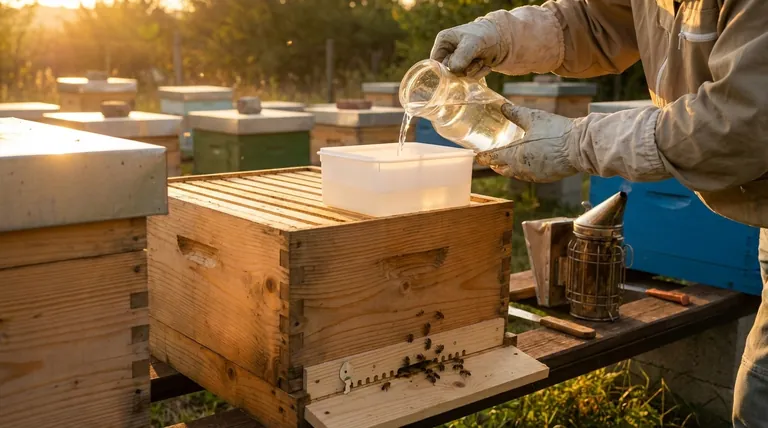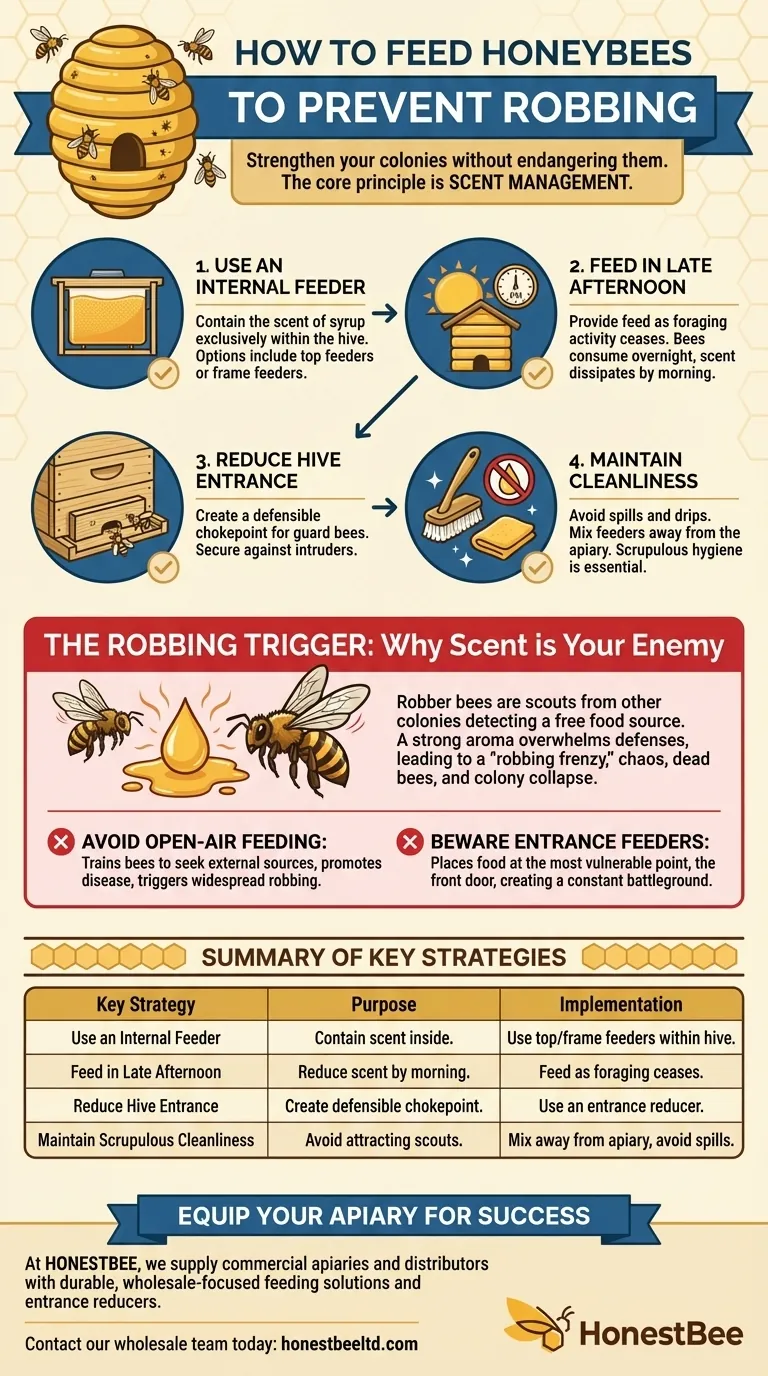Feeding your bees should strengthen them, not endanger them. To feed honeybees while preventing robbing, you must use an internal feeder to contain the scent, provide the feed in the late afternoon as foraging activity ceases, and ensure your hive is physically secure with a reduced entrance. Scrupulous cleanliness is essential; any spilled syrup acts as an open invitation to robber bees from neighboring colonies.
The fundamental principle of safe feeding is scent management. Robbing is an opportunistic behavior triggered when scout bees from other colonies detect a free and easy source of food. Your entire strategy must revolve around keeping the feed's aroma contained exclusively within the hive you intend to support.

The Robbing Trigger: Why Scent is Your Enemy
Robber bees are not malicious; they are foragers executing their natural directive to find food. When you feed a colony, you risk sending a powerful signal that can overwhelm their defenses.
How Robber Bees Discover a Target
Scout bees from strong, healthy colonies are constantly surveying their environment for nectar sources. A strong, sweet aroma from spilled syrup or an exposed feeder is an irresistible signal of a high-reward, low-effort food source.
The Escalation of a Robbing Frenzy
Once a few scouts find the source, they return to their hive and perform a waggle dance to recruit a massive force of foragers. This "robbing frenzy" can quickly overwhelm a weaker colony's guard bees, leading to chaos, dead bees, and the complete theft of all stored food, often causing the colony to collapse.
Strategic Feeding to Remain Undetected
Your goal is to provide nutrition so discreetly that no outside bees are even aware it's happening. This requires a methodical approach to feeder selection, timing, and cleanliness.
Choose the Right Feeder Type
The single most important decision you can make is selecting an internal feeder. These feeders are placed inside the hive, keeping the scent contained. Common internal options include top feeders, which sit above the inner cover, or frame feeders, which take the place of one or more frames inside the hive body.
Time Your Feeding Precisely
Always feed your colonies in the late afternoon or evening. Foraging activity naturally winds down as the sun sets. This gives your bees the entire night to consume the feed, clean up any minor internal drips, and allow the scent to dissipate before outside bees become active the next morning.
Maintain Absolute Cleanliness
Never mix feed or fill feeders near your apiary. Perform these tasks in a garage or shed to avoid attracting scouts. When placing feed in the hive, work quickly and avoid spilling or dripping any syrup on the outside of the hive or the ground. A single drop is enough to start a robbing event.
Securing the Hive: Your Colony's Last Line of Defense
Even with perfect feeding technique, a physically vulnerable hive is a target. Fortifying the hive structure is a critical, non-negotiable step.
The Critical Role of Entrance Reducers
An entrance reducer is your colony's best friend during a nectar dearth or feeding period. By shrinking the entrance, you create a smaller, more defensible chokepoint that the colony's guard bees can easily protect from intruders.
Perform a "Bee-Tight" Hive Inspection
Ensure your hive equipment is in good condition. Seal any cracks or gaps between hive bodies and supers where scent could leak out. A "leaky" hive is a scented billboard for every robber bee in the area.
Understanding the Trade-offs and Common Mistakes
Many common feeding practices inadvertently increase the risk of robbing. Understanding why they are dangerous is key to avoiding them.
The Danger of Open-Air Feeding
Open-air feeding, where syrup is placed in a tub or pan for all bees in an apiary to access, is extremely dangerous. It trains bees to seek food from external sources, promotes the spread of disease, and is the fastest way to trigger widespread robbing that will decimate weaker colonies.
Entrance Feeders: A Calculated Risk
Entrance feeders (like the Boardman feeder) are popular but place the food source at the most vulnerable point of the hive—the front door. This makes it incredibly easy for robber bees to find and creates a constant battleground at the entrance, which is why most experienced beekeepers avoid them, especially during dry periods.
Overfeeding Patties and Spoilage
When providing pollen or winter patties, only give the colony what it can consume in a few days. Uneaten patties can spoil, grow mold, or attract pests like small hive beetles, creating a new set of problems and attractants.
Making the Right Choice for Your Colony
Your feeding strategy must adapt to your colony's specific situation. Use these guidelines to make a safe and effective decision.
- If you are feeding during a nectar dearth: Use an internal feeder exclusively and reduce the hive entrance to its smallest opening.
- If you have a weak or new colony: Prioritize hive security above all else; a small entrance and a fast, clean feeding process are non-negotiable.
- If you are performing a routine inspection and feeding: Prepare all your equipment away from the hives to minimize the time they are open, and always work in the late afternoon.
By controlling the scent and securing the hive, you empower your bees to thrive on the support you provide.
Summary Table:
| Key Strategy | Purpose | Implementation |
|---|---|---|
| Use an Internal Feeder | Contain the scent of syrup inside the hive. | Use top feeders or frame feeders placed within the hive body. |
| Feed in Late Afternoon | Allow bees to consume feed overnight, reducing scent by morning. | Feed as foraging activity ceases for the day. |
| Reduce the Hive Entrance | Create a defensible chokepoint for guard bees. | Use an entrance reducer to shrink the opening. |
| Maintain Scrupulous Cleanliness | Avoid attracting scout bees with spilled syrup. | Mix and fill feeders away from the apiary; avoid spills. |
Equip your apiary with the right tools for safe, effective feeding.
At HONESTBEE, we supply commercial apiaries and beekeeping equipment distributors with durable, wholesale-focused feeding solutions—like secure internal feeders and entrance reducers—designed to protect your investment and prevent robbing.
Let's strengthen your colonies together. Contact our wholesale team today to discuss your needs.
Visual Guide

Related Products
- Professional Hive Front Entrance Bee Feeder
- Boardman Entrance Bee Feeder Durable Galvanized Steel and Wood Construction for Beekeeping
- Classic Boardman Entrance Bee Feeder Hive Front Feeding Solution
- HONESTBEE Professional Entrance Bee Feeder Hive Nutrition Solution
- HONESTBEE Entrance Bee Feeder Efficient Hive Front Liquid Feeding Solution for Beekeeping
People Also Ask
- How to make an entrance feeder for bees? A DIY Guide for Safe & Effective Feeding
- What are entrance feeders, and where are they located? A Guide to External Hive Feeding
- How does an entrance feeder work? A Guide to Its Simple Mechanics and Risks
- How does a beehive entrance feeder work? A Simple Guide to Supplemental Feeding
- What is an entrance feeder? A Guide to Its Simple Design and High Robbing Risk



















